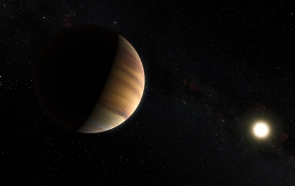A brief introduction to exoplanets
Since the discovery of the first exoplanet, a little more than two decades ago, thousands of planets have been found orbiting stars beyond our Solar System. Many of these newfound planets are very different to those that orbit our Sun and even the architecture of exoplanetary systems bears little resemblance to our own. As time has passed, a surprising amount of detail has been determined for some of these distant worlds. What is even more remarkable is how rapidly the field of exoplanetary research has grown in a relatively short period of time.
Planets beyond our Solar System – the first hints and discoveries
 |
| Artist's impression of 51 Pegasi b. Credit: ESO/M. Kornmesser/Nick Risinger (skysurvey.org) |
The first exoplanets discovered, and confirmed at the time, were two planets orbiting a pulsar – a dead star that emits beams of electromagnetic radiation. The discovery was made in 1992 by Aleksander Wolszczan and Dale Frail, working at the Arecibo Observatory in Puerto Rico and the National Radio Astronomy Observatory in New Mexico, USA. They detected the tell-tale subtle changes to the timing of the pulsar's pulsed emission that indicated the presence of the planets.
Three years later, in 1995, Michel Mayor and Didier Queloz from the Geneva Observatory in Switzerland announced that they had detected a planet in orbit around a Sun-like star, 51 Pegasi. This detection marked a pivotal moment in the study of exoplanets.
There had been earlier observations that suggested the presence of an exoplanet around a main sequence star. In 1988, a survey by Bruce Campbell from the University of Victoria, and Gordon Walker and Stephenson Yang from the University of British Columbia in Canada, found that the star gamma Cephei wobbled in an odd manner. Although the scientists first thought that this might be a planet, they decided that stellar activity would be a more likely explanation. It was only in 2003 that Artie Hatzes, from the Thüringer Landessternwarte in Germany, and his colleagues confirmed that a planet was orbiting gamma Cephei. David Latham at the Harvard-Smithsonian Center for Astrophysics and colleagues discovered a potential planet orbiting the Sun-like star HD 114762 in 1988, but at the time the planet was thought to be a brown dwarf – a failed star. It was finally confirmed to be a planet in 2012 by Stephen Kane and Dawn Gelino at the NASA Exoplanet Science Institute.
| Read more |
| 1: A brief introduction to exoplanets |
| 2: How to find an exoplanet - detection methods |
| 3: A zoo of exoplanets |
| 4: The future of exoplanet research |
